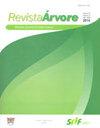人工遮荫和微咸水灌溉对花椰菜初期发育的影响伯南植物
IF 0.8
4区 农林科学
Q4 FORESTRY
引用次数: 2
摘要
利用管理策略或改变栽培环境可以降低灌溉水盐度对植物发育的影响。因此,在本研究中,本研究主要对桔黄(Anadenanthera colubrina)的生理反应、初始生长和植株品质进行了研究。在不同的遮阳和电导率灌溉水条件下,对布兰科(Angico Branco)进行了评价,寻求在微咸水中确定该物种发育的最有利条件。试验采用随机分组,分图进行,重复4次。这些地块由四种不同遮阳水平的环境组成:0(全日照)、30、50和70%,而子地块则由灌溉水电导率增加的五种水平组成:0.4、1.6、2.8、4.0和5.2 dS.m−1。评估了以下变量:基质电导率、叶片气体交换、株高、生物量产量和Dickson质量指数。使用人工遮荫有利于植物的发育和光合速率,即使灌溉中高盐度的水也是如此。DQI结果表明,在中等遮荫条件下(30%和50%)生产时,毛刺植株的品质指数较高,电导率高达2.8 dS.m−1的水灌溉时,产量损失在20%以下。本文章由计算机程序翻译,如有差异,请以英文原文为准。
EFFECTS OF ARTIFICIAL SHADING AND IRRIGATION WITH BRACKISH WATER ON THE INITIAL DEVELOPMENT OF Anadenanthera colubrina (Vell.) Brenan PLANTS
ABSTRACT The use of management strategies or changes in the cultivation environment can reduce the impacts of irrigation water salinity on plant development. Therefore, in this research, physiological responses, initial growth, and plant quality of Anadenanthera colubrina (Vell.) Brenan (Angico Branco) were evaluated under different levels of shading and electrical conductivity of the irrigation water, seeking to identify the most favorable conditions for the development of this species using brackish water. The experiment was carried out in randomized blocks with split plots and four replications. The plots were formed by four environments with different shading levels: 0 (full sun), 30, 50, and 70%, and the subplots, formed by five increasing levels of electrical conductivity of the irrigation water: 0.4, 1.6, 2.8, 4.0, and 5.2 dS.m−1. The following variables were evaluated: substrate electrical conductivity, leaf gas exchange, plant height, biomass production, and Dickson quality index at 40 days in a nursery. The use of artificial shading favored plant development and photosynthesis rate, even when irrigated with moderate and high salinity water. The DQI showed that A. colubrina plants presented higher quality index when produced under intermediate shading (30% and 50%), with yield losses below 20% when irrigated with water with electrical conductivity up to 2.8 dS.m−1.
求助全文
通过发布文献求助,成功后即可免费获取论文全文。
去求助
来源期刊

Revista Arvore
FORESTRY-
CiteScore
1.00
自引率
0.00%
发文量
32
审稿时长
4-8 weeks
期刊介绍:
A Revista Árvore é um veículo de comunicação científica da Sociedade de Investigações Florestais – SIF. O jornal é de acesso gratuito, revisado por pares, que publica bimestralmente trabalhos científicos originais no campo da Ciência Florestal. As áreas temáticas para publicação são: Ambiência e Conservação da Natureza, Manejo Florestal, Silvicultura e Tecnologia da Madeira e Utilização de Produtos Florestais.
A política editorial visa manter alta conduta ética em relação à publicação e aos seus funcionários, rigor na qualidade dos artigos científicos, seleção de revisores qualificados, respeito profissional aos autores e processo de tomada de decisão imparcial. A Revista Árvore publica artigos apenas em inglês.
Artigos de revisão podem ser publicados se houver uma discussão relevante resumindo o estado da arte sobre o assunto. A revisão estrita da literatura não é aceita.
 求助内容:
求助内容: 应助结果提醒方式:
应助结果提醒方式:


